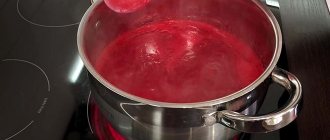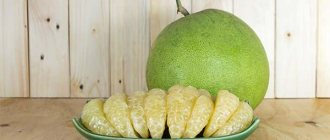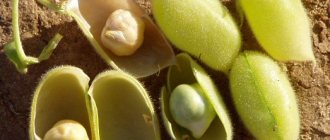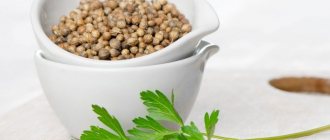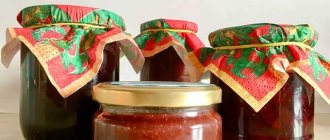You can make up legends. It contains the full vitamin alphabet (A, C, B1 and B2), zinc, potassium, iron. Ginger, and this is no secret, improves digestion. In cold weather, it warms the blood. It is an excellent assistant in the fight against excess weight. The Japanese even believe that pickled ginger gives a person determination, and also improves memory and communication abilities. In addition, ginger strengthens the immune system and eliminates nervousness. The best part is that it does not lose them even during pickling, let’s say even more - when pickling, ginger is endowed with unique abilities, in particular, it turns into an effective remedy against aging of the body, restores sexual energy, treats liver diseases, and also relieves unpleasant symptoms " seasickness."
Then wash your ginger root and very carefully slice it as thin as you want. Bring a pot of water to a boil and boil the ginger root for a few minutes until the ginger is soft. Combine rice vinegar, mirin and sugar in a medium mixing bowl and marinate the ginger overnight. First, you need to cut the ends of the ginger root and peel the skin. . This ingredient is quite easy to make at home and ensures that you are eating organic pickled ginger without any artificial food colors or preservatives.
To be fair, it is worth noting that pickled ginger has contraindications. Doctors recommend using ginger with extreme caution for people suffering from acute gastrointestinal diseases (gastritis, ulcers). Despite the fact that ginger is not contraindicated for pregnant women, it is still undesirable to use it in late pregnancy, as well as during lactation.
Being that it is pickled in vinegar, you can store the remaining ginger in a sealed container in your refrigerator and enjoy it later. Pickled sushi ginger is an extremely important ingredient in sushi and is served with every dish, next to a wasabi ball.
Using organic fruits and vegetables you can make natural food coloring! In most cases, these natural colors will not compensate for the taste. Ginger is also extremely sensitive to dyes. Conversely, you can use store-bought dyes to add some color to your ginger, but we all know how to do that.
Pickled ginger is well known to sushi lovers. Remember that pink rosette that comes with the sushi?
So, this is ginger, which is called gari. However, this pickled ginger is not used as a snack, but more as a mouth freshener that helps break up the taste before trying something new, similar to coffee beans when choosing a perfume. There is another variety of pickled ginger that the Japanese call beni-sega. They differ primarily in color: gari has a soft pink color, which young ginger turns into as a result of interaction with vinegar; to prepare beni-sega, mature ginger roots are used and marinated in plum vinegar. Beni-sega is never served with sushi, since it is always consumed as an ordinary pickled vegetable that can give the dish a special fiery taste.
Here's how you can color your ginger organically. Purple - This process is exactly the same as above, minus the baking soda. Boil the spinach leaves and pour them into a nice puree. You can add ginger puree or just use the juice. Orange - Carrots will do the trick - you can even use carrot juice sold in supermarkets! You can use canned beet juice from the store or brew your own.
- Blue - The secret of the organic blue dye is red cabbage.
- Chop your red cabbage and bring to a boil.
- Add some baking mixture and mix slowly.
- Use water and add it to your ginger.
- Let the mixture sit for several hours.
- You can find this stuff at most health food grocery stores.
- If it is not available to you, you can also use spinach leaves.
- Red – It goes without saying that beets take the gold.
- To make your own, simply boil or juice raw beets.
You should let your sushi ginger sit in the appropriate dye for at least a few hours, if not overnight.
Today we will prepare pickled ginger at home. There are a great many recipes for pickling ginger. However, it would not be amiss to tell you about the main secrets of successful cooking.
1. Use rice or plum vinegar to pickle ginger.
2. Ginger roots should be thick, smooth, with thick skin
.
Use these new, deliciously colored batches of ginger to make your plate pop! Have you been looking for that perfect ginger pickles recipe? Or Do you just want to know: “What is Ginger?” Then you will come to the right place. Sushi ginger and pickled ginger have a lot in common. They are actually the same thing. They are usually made by slicing young ginger very thin and then pickling it in a solution of vinegar and sugar.
Video: how to pickle ginger for sushi
Sushi ginger is usually meant to be eaten between bites of sushi to help cleanse the tray. This, along with green tea, really does a good job of preparing your taste buds for your next bite of sushi or sashimi. In fact, you can associate this process with eating a cracker before switching to another wine or during wine tasting sessions where many wines are sampled.
3. Red wine added to the marinade can give the dish an exquisite taste. Well, now we should present some interesting recipes for pickling ginger at home.
Recipe No. 1. A quick way to pickle ginger
We will need: Ginger roots – 200 g; Rice vinegar 3% – 250 ml; Salt - 2 teaspoons; Sugar – 2 tablespoons. For coloring (optional), you can use plum juice (1 tablespoon), rice wine (2 tablespoons) or a medium-sized beet cube.
Pickled ginger during pregnancy
The act of clearing the tray—whether with sushi ginger for sushi, breadcrumbs for wine, or milk for hot or spicy food—effectively neutralizes the tray and eliminates the possibility of competing food flavors clashing;
enhancing the overall food and drink tasting experience. Ginger sushi is preferably made with young ginger because it is sweeter, more tender, and tends to color slightly when marinated. However, they don't always use dye as I actually have a container of ginger in my fridge that is still a natural light brown color, it doesn't have any hint of pink in it.
Cooking method
1. Wash and peel the ginger. Cut into thin slices along the growth of the fibers. 2. Salt the ginger and leave for a few minutes (don’t worry if the ginger suddenly turns a little green). 3. Mix the ingredients for the marinade in a saucepan: vinegar, sugar, salt. Place over low heat and wait for the sugar to dissolve (but do not let the marinade boil). 4. Place ginger and coloring agent (optional) into the marinade and simmer over low heat for about half an hour. 5. Cool the ginger, transfer it to a jar, close the lid tightly and store in the refrigerator.
However, there is a lesson here. If there is no shade of pink for the sushi ginger, we know the ginger was not dyed and was probably not young ginger, but rather more mature ginger. If you only want to eat young and tender ginger or pickled ginger, then you'll want to pass this one on.
Choosing the best Sushinsky Ginger. Look at the image on the top left. If the ginger is dark red, then you know the sushi ginger has been dyed or tinted. Now look at the ginger sushi on the top right. Please note that it is light pink. This would be, in my opinion, the best chance of being the young, sweet, delicious ginger sushi you want to eat with your tender sushi.
Why is pickled ginger pink?
The Japanese use two methods of pickling spices. The first method uses ocet, and the second uses rice wine. It is the reaction of the vinegar that produces the best pickled ginger. The flavonoids contained in the plant react with the marinade and give the spice a light color. To give the final product a more saturated color, all that remains is to add beets or their juice.
The color saturation may depend on the plant variety and its age. Young roots near pickling have more intense shades. As for the variety, in this case several varieties of ginger are grown. Some do not even change the flora when canning, and the product remains white.
The Japanese use two methods for pickling spices. The first method uses vinegar, and the second uses rice wine. It is the reaction of the vinegar that gives pickled ginger its color. The flavonoids contained in the plant react with the marinade and color the spice pink. To give a more saturated color to the final product, you can add beets or their juice.
The color intensity may depend on the plant variety and its age. When pickled, young roots have more intense shades. As for the variety, several varieties of ginger are grown. Some do not even change color when canned and the product remains white. When purchasing ginger, you should pay attention to the label with information about the composition of the marinade.
There are many myths surrounding the coloring of spices. It is believed that the flavonoids in the root vegetable react with vinegar, causing the pickled product to acquire a coral color. In fact, the acid only affects the young root; the slices take on a dirty pink hue. While mature roots practically do not change color.
In both cases, such an appetizer looks unappetizing, so cooks began to add natural coloring pigments to the marinade:
- wine from dark grapes;
- vinegar;
- red berry juice;
- beets.
The degree of staining depends on several factors:
- age of the root, the older and thicker the rhizome, the more pigment required;
- the type of vinegar used (rice gives a slight yellowish tint, apple - creamy, wine - carmine);
- when dark wine is added, the root acquires a coral color;
- The brightest shade comes from beet juice.
Manufacturers use a variety of food colorings, each additive affecting the color in a special way. In retail chains you can find slightly pink and pink-raspberry pickled ginger.
When buying a root in a store, you will notice that its color varies from white or beige to pink and even burgundy. What is the difference and why is ginger pink? To prepare the pickled root, two traditional techniques are used, differing in one main ingredient - a preservative, which is rice wine or white wine vinegar. With the first ingredient, the root acquires a delicate pink color, while with the second it remains light.
There is one more observation. If a young root rich in flavonoids is pickled, upon contact with any acid, such as vinegar, they turn a delicate pink color.
It is not very difficult to determine young and old ginger by taste. The first has a more delicate taste and consistency. The second is more rigid due to the presence of a large number of fibers.
If you find a product in the store that is too intense in color, it means it was colored with food coloring or regular beet juice.
Pink young ginger is called gari, light last year is called beni-sega
Recipe No. 2. Ginger pickled in vodka and wine
We will need
: Ginger roots – 500 g; Rice vinegar – 200 ml; Red wine – 50 ml; Vodka – 50 ml; Sugar – 4 tablespoons.
Cooking method
1. Peel the ginger and put it in boiling water. Cook for 2 minutes. Then dry and cut into thin slices. Place in a jar. 2. Mix wine, vodka, salt and sugar in a saucepan. Put on fire and wait for the sugar to dissolve. Add vinegar. Boil. 3. Pour the prepared marinade over the ginger, close the jar tightly with a lid and put it in the refrigerator. 4. After a few hours, the ginger will acquire a pinkish tint, and after a couple of days it will be ready for use.
Just a process of elimination combined with an educated guess. If you're looking for someone and don't want to get out of the house, you can find a good selection of pickled ginger here at Amazon. Then we'll talk a little about ginger in general to reassure those who don't know much about it and are just interested in learning more.
How to make the most delicious pickled ginger for sushi
Cultivation began in South Asia and later spread to eastern Africa and the Caribbean. Ginger grows best in warm climates and is often used in landscaping in subtropical homes. It produces clusters of pink and white flower buds that later bloom into yellow flowers.
Recipe No. 3. Pickling ginger couldn't be easier
We will need
: Ginger roots – 500 g; Rice vinegar – 200 ml; Water – 2 liters; Salt – 1 teaspoon; Sugar – 3.5 tablespoons.
Cooking method
1. Peel the ginger and cut into thin slices. Place in a jar. 2. Boil water by adding salt. 3. Pour brine over ginger. After five minutes, drain off some of the water, leaving about 1 cup. 4. Mix the remaining brine with rice vinegar and sugar. Mix well until the sugar dissolves. 5. Pour marinade over ginger. Place in the refrigerator. 6. Ginger marinated according to this recipe at home is ready for use the next day.
It grows to about 3-4 feet tall and the roots are usually collected when the stem dies, after which it is scalded, washed and peeled to prevent it from sprouting. Ginger has long been used in all types of cooking in cultures around the world. For example, in the Western world it is used in many sweet dishes from ginger bread and ginger biscuits to ginger ale.
In Japan, it is used to make gari, grated and sprinkled with cheese on top of tofu and noodles, and is also used to make a candy called shago without sato-juku. In Nepal, it is one of the main ingredients used in making curry.
Pickled ginger is a seasoning that will add a spicy note to any dish.
This original spice is also very healthy, because ginger root contains a large amount of acids and vitamins.
The combination of benefits and original taste make this seasoning unique and irreplaceable.
How to select and store
A variety of product known as "Gari" is served with sushi, the root is cut into thin oval slices. A variation of “Beni shoga” is marinated shavings, less spicy than the first, served with meat and noodles.
It is preferable to purchase ready-made pickled ginger from well-known manufacturers. When purchasing, it is important to pay attention to the expiration date. Store ginger in the refrigerator; the temperature and shelf life are indicated on the package. The opened product is transferred to a tightly closed glass jar.
How to pickle ginger at home - basic cooking principles
We will tell you how to pickle ginger at home, and also share with you recipes for dishes in which you can use this seasoning.
And on the island of Corfu, Greece, it is used to make ginger beer called tsitsibira. Yes, you heard me correctly. Meatloaf. This gives the meatloaf an amazing flavor that is hard to describe. Most people can't understand what it is.
As you can see, ginger is used all over the world in almost every way. A truly flexible root with many culinary applications. Rumor has it that it can also give you enough health. Check out the next section to find out if the rumors are true!
What are the health benefits of ginger?
Ginger has long been believed to provide many beneficial medicinal benefits from aiding digestion, preventing skin cancer, and relieving nausea. And for centuries, the Ayurvedic tradition in Tibet and India has used ginger to treat inflammatory joint diseases, including arthritis and rheumatism.
For pickling, take the ginger root and peel it, trying to cut it off in a thin layer. Then the ginger root is cut into very thin circles against the grain.
The prepared product is placed in a small saucepan and poured with boiling water so that it completely covers the spice. The contents of the stewpan are salted and cooked over moderate heat for three minutes.
There is so much evidence out there, with a little history and folk knowledge mixed in for good measure, that this discussion needs to be taken a little slower; into bite-sized pieces. Ginger helps the distillation system. You see it in books and all over the internet all the time: Ginger helps with digestion. Well, it looks like preliminary medical research is starting to suggest that ginger actually helps with digestion.
There appear to be 9 identified compounds in ginger that may actually bind to human serotonin receptors, which may affect gastrointestinal function. This may also be partly caused by the use of volatile oils that are present in ginger, which increases the flow of fluid in the gastrointestinal tract.
Dissolve sugar in a glass of hot water, add vinegar and stir. The taste of pickled ginger should be rich and tart, so the pouring should be strong enough. You can add red wine or vodka to the marinade.
Drain the water from the ginger, cool and transfer it to a separate container that can be tightly closed. The spice is poured with marinade, covered with a lid and left to marinate for three days. The prepared seasoning is stored in the refrigerator.
Come on, ginger also tends to stimulate saliva production, and it looks like ginger may be the best natural way to a happy and healthy intestinal system that exists. Ginger is used in the treatment of nausea. In several studies, ginger was more effective than a placebo in treating nausea caused by seasickness, morning sickness, and chemotherapy. However, it has not been found to be effective against postoperative nausea.
And compared to over-the-counter edibles, ginger can provide superior relief from the commonly felt effects of dizziness, cold sweats, and upset stomach with the added benefit of being completely natural, safe, and free of side effects.
Pickled ginger is added to fish, meat or seafood dishes. Most often it is used for making sushi and rolls. This spice can also be added to baked goods.
For weight loss
Another argument in favor of consuming pickled ginger is a homemade recipe for weight loss without any pills or exhausting diets. The fat-burning properties of this plant are known, which can be successfully used in the difficult task of fighting excess weight. There is practically no special scheme, as well as a specific ginger diet. But, judging by the reviews of practitioners, you can adjust your weight quite effectively. By the way, if you also drink ginger tea before meals (half an hour before), this will help reduce the feeling of hunger.
Pickled ginger can be added to dishes as a seasoning, or it can be eaten separately as a snack. The main thing here is regularity of use. And with sufficient vital activity and exercise, you can lose up to 10 kilograms per month! Of course, it is better to simultaneously establish proper nutrition, give preference to plant foods, and give up smoking and drinking alcohol.
Recipe 1. Pickled ginger
Ingredients
300 g ginger root;
half a glass of table vinegar;
half a glass of sugar;
half a liter of drinking water;
And if these two examples aren't enough to convince you, here are some more studies to consider when looking for the health benefits of ginger. Ginger has been used in folk medicine for much longer than it has been used in the practice of medicine. And any discussion of the use of ginger to treat illness would be incomplete without mentioning at least some of its uses in folk medicine.
Traditionally, this medicinal form of ginger was called Jamaica ginger and was used to treat indigestion, relieve gas, sluggishness, constipation and colic. Tea made from ginger is used as a common cold remedy. C. ginger is used to relieve illness and morning sickness; In Japan it is used to promote blood circulation. Ginger has been used to treat illnesses for thousands of years by cultures throughout the word. It is one of the few products that has stood the test of time and one that is still used today to treat the same ailments it was used to treat centuries and sometimes millennia ago.
finely ground salt.
Cooking method
1. Wash and peel the ginger root. Using a vegetable peeler, cut it into thin slices. Place in a suitable container, sprinkle with a teaspoon of salt and leave overnight.
2. Add half a glass of table vinegar and the same amount of sugar to half a liter of boiled water. Mix well. We slightly dry out the ginger and transfer it to a saucepan, pour half of the marinade into it and put it on moderate heat. From the moment it boils, cook the ginger for about ten minutes.
The difference between then and now is that science and medicine are now beginning to support what some cultures have already known for hundreds or even thousands of years. This ginger is truly close to curing every super root we will ever find.
Clean the ginger root with a vegetable cleanser or use a spoon to cleanse the skin. Slice the ginger root as thinly as possible. Place the chopped ginger in a bowl and sprinkle salt over it. Mix well and let stand for 1 hour.
Place the ginger slices in a sterilized container or jar. Add rice vinegar and 2ct sugar. pot and stir until the sugar is completely dissolved. Bring the vinegar and sugar mixture to a boil. Pour the mixture into a jar and let it cool. Place the lid on the jar and store in the refrigerator.
3. Select ginger with a fork and transfer it to a jar, fill it with the remaining marinade, close the lid tightly and put it in the refrigerator. After two days we can eat the spice.
Contraindications and harm of ginger
Pickled ginger also has contraindications. It is important to consider restrictions on consumption in the presence of certain pathologies, so as not to cause harm to health.
The pickled root has few contraindications:
- the root can cause allergic reactions;
- with increased acidity, ulcerative formations in the gastrointestinal tract, exclude all products with vinegar;
- The marinade has a negative effect on diseased liver and kidneys.
The main condition is moderate consumption of spices, then the effect will be positive.
Despite all the advantages of this product, there are some restrictions and prohibitions on its use as a dietary supplement. The spice should not be consumed by people suffering from serious stomach diseases, women expecting a new addition to the family, or people with acute forms of chronic diseases.
Despite all the advantages of this product, there are some restrictions and prohibitions regarding its use as a dietary supplement. The spice should not be consumed by people suffering from serious stomach diseases, women awaiting co-optation in the family, or people with acute forms of chronic diseases. Some people may experience an allergic reaction to the product, in which case use should be stopped immediately.
Recipe 3. Pickled ginger with vodka
Ingredients
200 g young ginger root;
50 ml wine vinegar;
10 ml vodka;
45 g granulated sugar.
Cooking method
1. Wash the ginger root, dry it with a napkin and peel it. Cut into pieces, place on a plate and pour boiling water over the ginger. Leave for two minutes, then remove the seasoning and dry. Cut the ginger root into thin slices with a vegetable peeler.
2. Pour wine vinegar into a saucepan, add a spoonful of drinking water, sugar, vodka and salt. Stir, boil the marinade over moderate heat and cool.
3. Scald a glass jar with boiling water, place the ginger in the prepared bowl and pour the cooled marinade over it. Cover tightly and leave for at least five hours. Serve the seasoning with fish or meat dishes.

